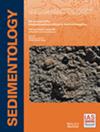Microbial dominated Ca-carbonates in a giant Pliocene cold-seep system (Crotone Basin – South Italy)
IF 2.8
2区 地球科学
Q1 GEOLOGY
引用次数: 0
Abstract
The Pliocene cold-seep carbonate of the Crotone Basin (South Italy) represents a key site for dimension, outcropping exposure and quality. These deposits form a large carbonate (calcite) body (350 m long, 100 m wide and 40 m thick), and are characterized by a conduit facies made of authigenic calcite interpreted as previously active gas/fluid escape pipes and by a pavement facies, depicted as the surrounding early calcite-cemented bioclastic and siliciclastic sediments. Pavement facies are commonly colonized by chemosymbiotic and non-chemosymbiotic macrofauna (Lucinid and Solemyid bivalves, gastropods and serpulids). The conduit microfacies is characterized by the inward accretion of dark micritic laminae alternating with whitish sparitic layers. The micritic laminae show a microbial peloidal to dendrolitic fabric, which commonly incorporates planktonic foraminifera and coprolites, whereas the crystalline layers consist of microsparitic and sparitic crusts of prismatic zoned calcite crystals. The pavement facies shows more variability, because it is typified by laminated microbial boundstones, chemosymbiotic–bivalves packstone, foraminiferal packstone/wackestone and hybrid arenites. The stratigraphic constraint coupled with the foraminiferal assemblage (planktonic taxa) suggest a deep-water setting occasionally affected by siliciclastic sedimentary flows. The pavement facies also shows common brecciation features, suggesting the establishment of post-depositional overpressure conditions due to the early cementation of the conduits, which triggered localized rock failure. Stable isotope analysis of the different facies reveals overall negative δ13C values (−6.8 to −37.4‰ Vienna PeeDee Belemnite), indicating the presence of a complex mixture of methane with other hydrocarbons consumed microbially via anaerobic oxidation of methane; whereas δ18O is relatively positive (0.0 to 3.4‰ Vienna PeeDee Belemnite) suggesting the possible dehydration of clay minerals and/or destabilization of gas hydrates. This study, besides helping in the definition of the migration pathways and modality of accumulation of hydrocarbon-rich fluids, can also help in building more and more realistic models for the complex genesis of cold-seep carbonates.上新世巨型冷渗系统(意大利南部克罗托内盆地)中以微生物为主的钙碳酸盐
克罗托内盆地(意大利南部)的上新世冷渗碳酸盐岩是一个重要的尺寸、露头和质量地点。这些沉积物形成了一个大型碳酸盐(方解石)体(长 350 米、宽 100 米、厚 40 米),其特征是由自生方解石构成的导管面和路面,前者被解释为以前活跃的气体/流体逸出管道,后者被描述为周围的早期方解石胶结生物碎屑岩和硅质沉积物。路面层通常有化学共生和非化学共生大型动物(双壳类、腹足类和蛇足类)。导管微地层的特点是深色微晶层与白色麻粒岩层交替向内堆积。微砂岩层呈微生物球状至树枝状结构,通常含有浮游有孔虫和桡足类,而结晶层则由棱柱状方解石晶体组成的微石英壳和麻粒岩壳组成。路面层的变异性更大,因为它以层状微生物结合岩、化生双壳类包岩、有孔虫包岩/瓦基岩和混合 arenites 为典型特征。地层限制加上有孔虫群(浮游类群)表明,这里是一个偶尔受到硅质沉积流影响的深水环境。路面层还显示出常见的角砾岩特征,这表明由于导管的早期胶结,沉积后超压条件已经形成,从而引发了局部岩石崩塌。对不同岩层的稳定同位素分析显示,δ13C 值总体为负值(-6.8 至 -37.4‰ Vienna PeeDee Belemnite),表明存在甲烷与其他碳氢化合物的复杂混合物,甲烷通过厌氧氧化作用被微生物消耗;而δ18O 值相对为正值(0.0 至 3.4‰ Vienna PeeDee Belemnite),表明粘土矿物可能脱水和/或天然气水合物不稳定。这项研究除了有助于确定富含碳氢化合物的流体的迁移途径和聚集方式外,还有助于建立更多更现实的冷渗碳酸盐复杂成因模型。
本文章由计算机程序翻译,如有差异,请以英文原文为准。
求助全文
约1分钟内获得全文
求助全文
来源期刊

Sedimentology
地学-地质学
CiteScore
8.20
自引率
11.40%
发文量
94
审稿时长
6-12 weeks
期刊介绍:
The international leader in its field, Sedimentology publishes ground-breaking research from across the spectrum of sedimentology, sedimentary geology and sedimentary geochemistry.
Areas covered include: experimental and theoretical grain transport; sediment fluxes; modern and ancient sedimentary environments; sequence stratigraphy sediment-organism interaction; palaeosoils; diagenesis; stable isotope geochemistry; environmental sedimentology
 求助内容:
求助内容: 应助结果提醒方式:
应助结果提醒方式:


